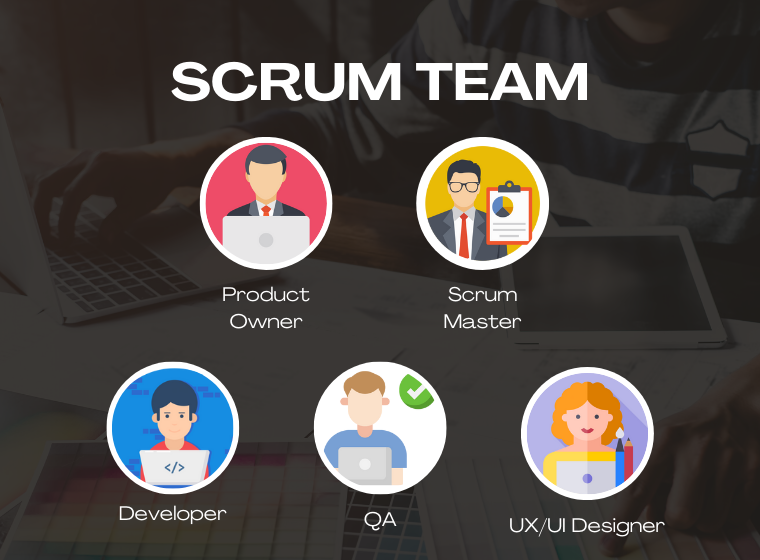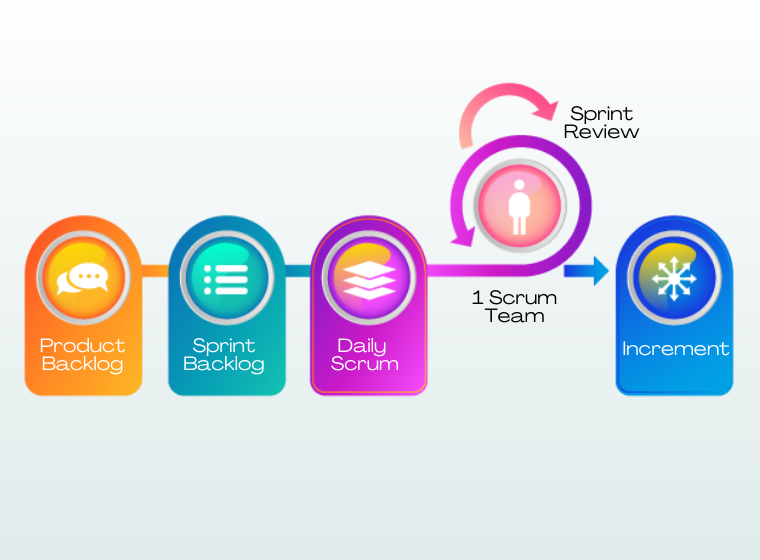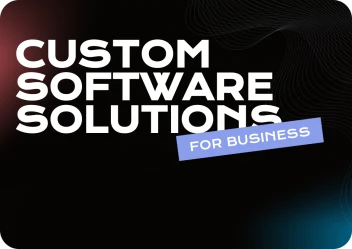Almost all IT-companies today seem to use Agile methodology for software development, or at least they think they do. Agile is an approach that promotes iteration, meaning that a software is built incrementally. In the Agile environment, both development and testing take place in parallel, unlike it was before with Waterfall model. Agile project management is flexible allowing the client and development team to make changes at any stage of the working process. This way Agile maximizes the value of the product during the development process. All mentioned qualities make Agile the go-to method for helping IT startups and development teams organize collaboration and create a quick and efficient product.
What Is Agile Methodology
It’s a tricky question, because the word “methodology” means a set of principles and rules applied in a discipline. But Agile itself embraces the avoidance of any prescribed methods and procedures. Agile doesn’t include any definite methods. It’s not a methodology in the usual sense of the word. It’s rather a guidance of ideas on how to choose the right methods enabling an IT-team to work efficiently. If translate to English “agile” means “being able to move quickly and easily.” Thus, agility is the ability to constantly adapt, change and make improvements on the way.
A Bit Of History
Agile was established in 2001 by a group of 17 proficient IT specialists that gathered at a mountain resort in Utah. All of them agreed on a core idea: companies are more focused on planning and documenting rather than satisfying the customer’s needs. The result of this meeting was the agile manifesto. It includes 4 main principles for agile project management that are as follows:
- Individuals and interaction between them is more important than processes and tools
- Well-functioning software is more important than a well-written documentation
- Effective collaboration with a client is more important than contract conditions
- Adapting to changes is more important than following a plan
How It Works
Agile implies dividing the whole project into a series of smaller tasks (usually they are called user stories) and prioritizing them. User stories are delivered in small cycles called sprints. It’s essential for a team to prioritize the tasks and focus on one Scrum sprint to achieve the best possible result at the moment. Different stages of product creation - planning, building, testing, reviewing - repeat until the final product is launched. Agile teams are well-organized and self-motivated because Agile helps create a kind of rhythm and friendly environment in which the team performs. Though initially the agile manifesto emphasized the importance of direct communication, today, in the period of COVID-19 pandemic and lockdown limitations, Agile still remains relevant. Just now, all daily meetings, regular communication and collaboration moved to Zoom and online space.
Why to Choose Agile
- You receive a quality product. A well-working software product is the main indicator of successful work and team collaboration in Agile. Earlier, it was a common thing to test a software right before its final launch. With Agile, testing is made in the end of each sprint. This strategy allows making changes on the go and catch all bugs before the product delivery.
- You get a speed. Sprints - set periods of time - allow the development team to deliver product changes frequently and fast. A software product is released after each sprint. It may lack some functionality, but it’s absolutely working.
- You are able to make changes on the way. When using Agile, changes in requirements are welcome, as they contribute to the customer’s competitive advantage. The development team systematically analyzes possible ways to improve efficiency and adjust to new requirements. There is always a room for mistakes and improvements.
- You get a team of highly-motivated and self-organized professionals. Direct interaction and the atmosphere of trust and support are cultivated in Agile environments. Exchanging of the information inside the team helps smoothly move toward the common goal.
- You are the part of the project. Clients, developers and other people involved in the project are constantly communicating with each other. All decisions are made together, you can always express your thoughts and ideas.
Agile is an umbrella term for a variety of techniques that share the same values and ideas. Each of them are used in distinct fields and own different features. The most popular Agile frameworks include Scrum, Kanban, Hybrid, Lean, Bomodal, and XP. Today, we are going to shed some light on the Scrum method that is widely used in IT surroundings.
Scrum As The Most Popular Agile Framework
This term was borrowed from rugby team formation, when they restart play, and was introduced in the paper by Takeuchi and Nonaka in 1986, published in Harward Business review. Highly effective, cross-functional teams can be compared to rugby close-knit teamwork. Scrum is a process in which a set of IT practices is applied on a regular basis to work collaboratively, as a team, and obtain the best possible result from a project. These practices support each other and their selection originates from a study of how highly productive teams work.
Why “Scrum”?
In Scrum methodology, partial and regular deliveries of the final product are made, prioritized by the benefit they bring to the recipient of the project. For this reason, Scrum is especially suitable for:
- projects in complex environments
- where you need to get results soon
- where the requirements are changing or poorly defined
- where innovation, competitiveness, flexibility and productivity are essential
Basically, Scrum is not a technique or a process it is a simple and short framework to tackle complex problems in a project and deliver a high value IT product in a creative way.
So What Are the Main Distinctive Attributes of Scrum Framework?
Simplicity
Scrum is not a complex study and can be assessed easily, it helps minimize the time and avoid wasting it for non-crucial activities at every certain moment. Shortly, after each sprint you may have a draft project. Development in Scrum is done in sprints, which are 1, 2 and 3 weeks long depending on a project, this approach facilitates concentration on a particular project or its part at a short period of time.
Flexibility
There is no correct Scrum, as well as no “incorrect” one. Its flexibility belongs to each and every point in this framework. No set rules, therefore no restrictions. This allows the development team to be flexible enough to adapt to those changes if the company changes its mind. The ability to accommodate the project to change is one of the most useful features of Scrum framework.
Client-oriented
Scrum is adaptive and gives the client a chance to make changes to the project any time. It is based on just-in-time planning, undoubtedly, a stunning option for clients who know what they want and desire to follow every step in project development.
There Are 3 Main Roles in Scrum Team:
Product owner
The primary responsibility of the Scrum product owner is to maximize the value of the product and the work of the development team. Additional tasks include managing the Product Backlog.
Scrum Master
The certified Scrum Master makes sure that the team complies with the theory and its rules, helps the team boost their effectiveness by removing obstacles on their way, gives assistance.
Development Team
The development team consists of self-organizing professionals, ideally between 5 and 9 members, who convert Product Backlog into Increments, therefore they possess all the necessary skills to do it.
Sounds pretty complicated, but it’s vice versa. Scrum facilitates effectiveness and collaboration on each phase. The team achieves collaboration in different ways, but to understand it properly best will be just penetrate into the process itself.

The Scrum Process Explained
In scrum the process stages are called rituals, because alike rituals they are rigorously followed. These are:
- Sprint Planning Meeting
The process starts from the product's prioritized list of objectives / requirements. It is necessary to define what will be done and how. The objective for each sprint are set according to the Product Backlog, mainly the tasks which are most relevant and complex.
- Daily Meeting
In order to apply the principles of inspection and adaptation the whole team meets on a daily basis for a Daily Scrum and each member briefly reports on what was done yesterday, what will be done today, as well as on the possible problems to achieve the project objective.
- Sprint Review
This stage makes Scrum so special as seldom the “raw” product is shown. In Sprint Review or Demo the product or the result that is present can get feedback, evaluation and impetus to an improvement. Likely, it helps not only to keep the team motivated, but rather save time and energy as in other project models the product is demonstrated only in its “final” version, after months of work.
- Retrospective
Crucial part of the Scrum framework is retrospective as it’s about the team itself. Here the team will discover what they did right, what was wrong and how to improve, so-called evaluation meeting.
Often, the project can be so complex and versatile that one Scrum Team is not enough to cope with it, then a number of qualified specialists will save the day. What can be better than one Scrum team? Right, several Scrum teams working together. As a result we’ll get Scrum of Scrums where the roles and coordination method are defined the same way.
Takeaways
In spite of increased criticism, most agile principles are still relevant today, especially in the time of pandemic. It’s because they are based on the human nature. Collaboration is becoming even more essential now as projects increase in size and scale. When implemented in a right way, agile Scrum method works wonders for IT projects and developers, even if they collaborate remotely. As nobody knows when the pandemic ends, it means that most companies will continue to work online. The development teams will have to stay goal-driven and productive towards achieving the common goals, and Agile could come in handy.









